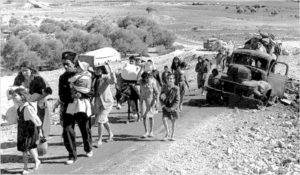 1922 – The League of Nations recognized the historical connection of the Jewish people with Palestine.
1922 – The League of Nations recognized the historical connection of the Jewish people with Palestine.
1947 – UN Partition Resolution 181 recommended the creation of Arab and Jewish states with specified boundaries. Arabs rioted and blockaded Jewish Jerusalem.
1948 – The UN General Assembly passed Resolution 194 which stated “refugees wishing to return to their homes and live at peace with their neighbors should be permitted to do so at the earliest practicable date,” adding that refugees who do not wish to return are entitled to compensation for their property.
1949 – When fighting ended, Israel held territories beyond boundaries set by UN Partition Resolution 181 including 78 percent of the area west of the Jordan River. Egypt controlled the Gaza Strip and Jordan the remainder of the West bank and east Jerusalem. UNRWA was created to provide relief and work programs for refugees. Palestinians rejected an Israeli offer to repatriate 100,000 refugees as well as some refugees who had been separated fro their families, and to release accounts frozen in Israeli banks.
1950 – Jordan annexed the West Bank and eastern Jerusalem. Only Great Britain and Pakistan recognized the annexation.
1963 – The Palestine Liberation organization (PLO) was established.
1967 – The Six-Day War left Israel in control of the Gaza Strip, the West Bank, and eastern Jerusalem. The UN estimated that during the fighting, 175,000 Palestinians fled for a second time and 350,000 for the first time. UN Resolution 242 called for Israeli withdrawal from territories occupied in the conflict, a just settlement of the refugee problem, and secure borders and peace.
1970 – Jordan expelled Palestinians and PLO factions challenging the power of its government. Many fled to Lebanon.
1978 – The Camp David Accords included a proposal for Palestinian self-government.
1987 – The First Intifada began in the West Bank and Gaza Strip.
1982 – In an effort to crush the PLO after continuing attacks on northern Israel, Israel invaded Lebanon. Israel was criticized by the international community for allowing right-wing Lebanese Phalangist militia allied to Israel to commit massacres in the Sabra and Shatilla refugee camps in Lebanon. Israeli military sources estimated that between 700 and 800 people were killed. The International Red Cross estimated 2,400 were killed.
1993 – The Oslo Accords established the Palestinian Authority and security forces. West Bank camps came under Palestinian control; Shufat and Kalandia camps remained under Israeli control; and six – Deir Ammar, Jalazone, Fawwar, Arroub, Fara, and Nur Shams – under joint Palestinian-Israeli control.
1994 – Palestinian self-government was implemented in parts of the Gaza Strip and Jericho.
1995 – Broader Palestinian self-government was implemented throughout the West Bank and Gaza Strip. The Palestinian Council was elected. Israeli troops withdrew from Gaza, Hebron and most other cities and towns in the West Bank.
1998 – Under the auspices of the Wye River Memorandum, Fara and Nur Shams camps were placed under Palestinian Authority control.
2000 – Palestinian violence followed the failure of the Camp David summit, using the excuse of Ariel Sharon’s visit to the Temple Mount.
2001 – Egypt tried to resolve differences in Taba but Palestinians rejected the settlement offer.
2002 – Israel sent ground troops into major Palestinian towns to root out terrorist re-occupying Jenin, Ramallah, Nablus, Tulkarm and other towns. In Jenin 23 Israeli soldiers and 100 Palestinians were killed. Despite initial charges of a “massacre,” Amnesty International determined that none occurred and no human rights were violated.
2003 – The “road map” offered by the U.S., the European Union, Russia, and Great Britain offered a solution to the Palestinian-Israeli conflict as did the unofficial Geneva Initiative. Both addressed the refugee problem.